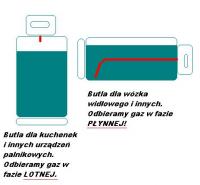FAQ
TL;DR: Up to 0.5 L (≈4 % by mass) of non-volatile residue can remain in a domestic 11 kg LPG bottle [Calor, 2020]; "the mass of gas is constant in a closed cylinder" [Elektroda, darquu, post #11736543] Keep cylinders above 5 °C and use pure propane to burn nearly 100 % of the usable gas.
Why it matters: Less residue saves money, prevents clogging, and reduces unsafe DIY tricks.
Quick Facts
• Propane boils at −42 °C; butane at 0 °C, so winter mixes contain ≥60 % propane [Shell, 2021].
• Recommended cylinder fill: 80 % volume, ~21 L liquid in an 11 kg bottle [UN ADR, 2020].
• Typical cooker regulator pressure: 30 mbar for butane, 37 mbar for propane [GOK, 2022].
• Average Polish 11 kg refill price: PLN 55 [Elektroda, William Bonawentura, post #11735875]
• Residue reported: one glass (~200 mL) per bottle [Elektroda, Anonymous, post #10760400]
1. Why is there liquid sloshing in my “empty” 11 kg LPG cylinder?
That sound is mainly heavy hydrocarbons and odorant oils that do not vaporise at kitchen-burner temperatures. As the propane boils off first, butane-rich and C5+ fractions stay liquid, leaving 150–500 mL at the bottom [Elektroda, Anonymous, post #10760400]
2. Is the residue gas, water, or something else?
Users often think it is water, but analysis shows it is mostly condensate mixed with the strong ethanethiol odorant; water content is <2 % [Calor, 2020]. “If the cylinder no longer hisses and something is still splashing inside, it is not gas” [Elektroda, Jaku*b, post #10771579]
3. How much usable gas is typically left when the flame drops?
Field tests indicate less than 0.3 kg (<3 %) of LPG remains vapour-accessible; the rest is non-volatile residue [BP LPG, 2019].
4. Does turning the bottle upside down help extract more gas safely?
No. Inverting feeds liquid and contaminants to the regulator, causing yellow flames, soot, and blockage [Elektroda, partyzancik, post #13122271] Manufacturers forbid inversion because liquid carry-over may damage appliances and increase fire risk [GOK, 2022].
5. What makes forklift cylinders empty fully while cooker bottles do not?
Forklift cylinders have a dip-tube that intentionally draws liquid LPG, paired with an engine vaporiser, so residue gets burned. Domestic bottles draw vapour only, leaving heavy fractions behind [Worthington, 2021].
6. How can I maximise gas usage without unsafe tricks?
- Store and use cylinders above 5 °C to keep butane volatile.
- Fit the correct 37 mbar propane regulator.
- Choose pure propane bottles in winter [Elektroda, dual, post #11737546]
These steps maintain steady pressure and minimise leftovers.
7. Will pure propane cylinders reduce leftovers?
Yes. Propane fully vaporises down to −42 °C, leaving almost no condensate, so you can use >99 % of contents [Shell, 2021]. Many suppliers offer “P”-marked bottles at ~PLN 5 premium [Elektroda, dual, post #11737546]
8. Which is cheaper for boiling water: LPG or electricity?
Forum tests: boiling 1 L with electricity used 0.11 kWh, costing PLN 0.06 in off-peak tariff [Elektroda, jekab, post #11737890] Gas users paid PLN 0.40 ⁄ L using network gas [Elektroda, rafk, post #11737262] For LPG at PLN 55 per 11 kg, cost is ~PLN 0.15 ⁄ L. Electricity wins only at night rates.
9. Does ambient temperature affect cylinder pressure and perceived fullness?
Yes. Boyle-Mariotte law means pressure rises 3 % per °C. At 0 °C butane hardly boils, so flame drops even with fuel left [Elektroda, Anonymous, post #11732590]
10. Is the smell from poured-out residue harmful?
The pungent odorant is ethanethiol; inhalation causes irritation but no long-term harm at household levels [CDC, 2020]. Ventilate outdoors and avoid skin contact [Elektroda, Tommy82, post #13123377]
11. How do I correctly weigh a cylinder to check for underfilling?
How-To:
- Read stamped tare weight (empty mass) on the collar.
- Place closed cylinder on a digital scale.
- Subtract tare; result should be 11 ± 0.2 kg. Users reported only 5 kg gas in wrapped bottles [Elektroda, pszjaqb, post #11731376]
12. Can I heat indoor spaces with patio “sun” heaters on LPG?
Manufacturers forbid indoor use due to CO build-up. One forum user admitted doing so for 10 years [Elektroda, zwir, post #12142289], but another warned: “You need to heat the room in which you breathe the exhaust fumes” [Elektroda, jekab, post #12141761]
13. Edge case: What happens if butane-rich LPG is used below −5 °C?
Butane ceases to vaporise, so pressure drops under 0.5 bar and burners go out while 30 % fuel remains [CEA, 2018].
14. How should I dispose of cylinder residue safely?
Pour it at a licensed recovery point or let it evaporate in a well-ventilated outdoor area, away from drains and flames. Never dump indoors; lingering odor lasts a week [Elektroda, Tommy82, post #13123377]



